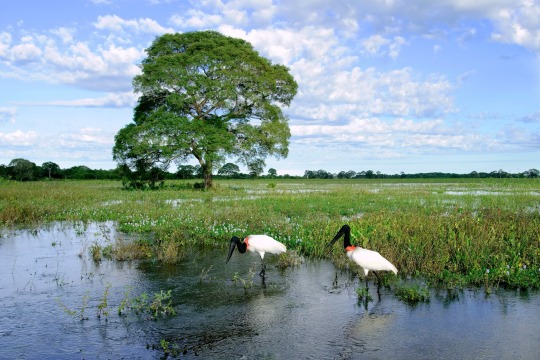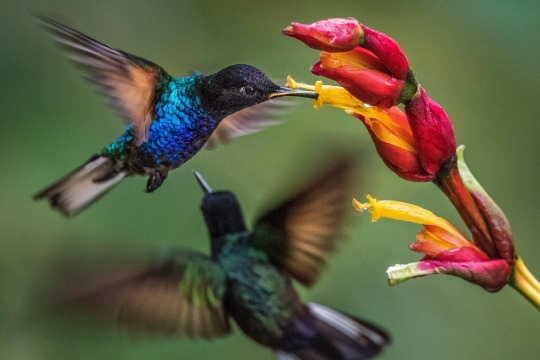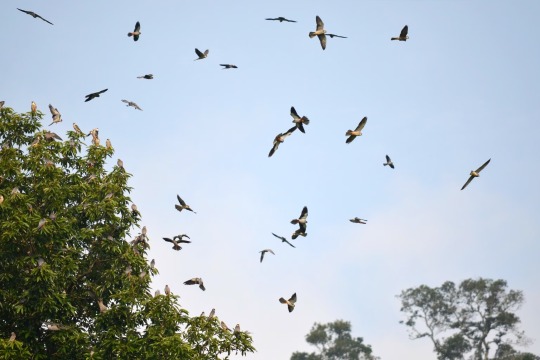#Nature | Birds 🦆 🦢 🦅
Explore tagged Tumblr posts
Text
Night Photography!

A "Wolf Moon" Hovers Over the Frigid Sangre De Cristo Mountains at Twilight, San Luis Valley, Colorado.

Glowing tents dot the grass around Les Cheserys Lake in the French Alps.

A grove of Giant Sequoia Trees frame a towering white fir tree under starry skies in Sequoia National Park, California.

An Aurora Borealis Bends across the sky in South East Greenland.

Grotto Geyser Steams under star-filled skies at Midway Geyser Basin in Yellowstone National Park.

Arbol de Piedra (The Stone Tree), is a 20-Foot-Tall Rock Formation in Bolivia’s Eduardo Avaroa Andean Fauna National Reserve.

An Inverted Crescent Moon hanging high over the Kalahari Desert at twilight, South Africa.

Forest elephants graze in the grasslands of central Gabon. While many people often want to go up close when it comes to animal photography, it sometimes helps to take some distance and create images that create a sense of place.

With plenty of practice and patience, kids can capture sweet photographs like this one of a Canada Goose and Her Goslings. Photograph By Melissa Groo Photography

A Marbled Godwit stands in Bowdoin Lake in Montana. Photograph By Melissa Groo Photography
0 notes
Note
HAPPY BIRD DAY!!!! 🦃🐔🐓🐣🐤🐥🐦🐧🕊🦅🦆🦢🦉🦤🪶🦩🦚🦜
Woah, Birds. Nature is wonderful.
11 notes
·
View notes
Video
youtube
Birds 4K Of The World - Science Relaxation Film With Beautiful Birds.
Welcome, bird enthusiasts and curious minds alike, to a soaring journey through the avian kingdom! 🦜🌟 In this blog post, we'll embark on an exhilarating adventure to discover 63 of the most captivating and diverse birds that grace our skies and inhabit our planet. From the majestic to the quirky, each feathered friend brings its own unique charm and contributes to the vibrant tapestry of our natural world. So, fasten your seatbelts as we take flight into the mesmerizing realm of birds, where colors, songs, and adaptations tell tales of survival and beauty. Join us as we unfold the wings of wonder and delve into the captivating stories behind these enchanting creatures. 🕊️✨
🦅 Bald Eagle
🦆 Mallard
🦉 Owl
🦢 Swan
🦜 Parrot
🦚 Peacock
🦩 Flamingo
🦔 Hedge Sparrow
🦆 Mandarin Duck
🦢 Mute Swan
🦆 Wood Duck
🦉 Barn Owl
🦩 Roseate Spoonbill
🦜 Cockatoo
🦚 Indian Peafowl
🦢 Trumpeter Swan
🦆 Pintail Duck
🦉 Snowy Owl
🦜 Macaw
🦩 Scarlet Ibis
🦚 White Peafowl
🦢 Whooper Swan
🦜 Amazon Parrot
🦆 Teal Duck
🦆 Eider Duck
🦚 Ostrich
🦢 Black Swan
🦩 Shoebill
🦉 Great Horned Owl
🦜 Lovebird
🦢 Coscoroba Swan
🦚 Emu
🦩 Northern Jacana
🦜 Budgerigar
🦉 Snowy Egret
🦆 Harlequin Duck
🦢 Tundra Swan
🦩 Spoonbill
🦉 Burrowing Owl
🦜 Lorikeet
🦚 Cassowary
🦢 Bewick's Swan
🦩 Avocet
🦜 Quaker Parrot
🦉 Long-eared Owl
🦆 Canvasback Duck
🦚 Secretary Bird
🦢 Andean Flamingo
🦩 Black-necked Swan
🦜 Conure
🦢 Toco Toucan
🦩 Ibexian Crane
🦜 Sun Conure
🦆 Common Eider
🦚 Blue Jay
🦉 Short-eared Owl
🦢 Chilean Flamingo
🦩 Red-crowned Crane
🦜 Eclectus Parrot
🦆 Bufflehead Duck
🦚 Jay
🦢 Greater Flamingo
🦩 Japanese Crane
0 notes
Photo

On January 5th As the United States marks National Bird Day on Jan. 5, the majority of bird species in the U.S. face a grim future in coming decades if environmental efforts, such as mitigating climate change and decreasing habitat degradation and loss, are not implemented on a larger scale. National Bird Day is scheduled to coincide with the annual Christmas Bird Count, which lasts three weeks, and is the largest citizen science survey in the world, keeping track of America's wild birds. Nature lovers, bird lovers, and bird watchers across the country annually recognize National Bird Day on January 5th. It's also one of several designated holidays celebrating birds. National Bird Day has been dedicated at least in part to raising awareness about birds that are held in captivity. This day is a project of the Avian Welfare Coalition, which works hard to raise awareness for birds that are captured or produced in captivity for either profit or amusement of humans. Please Take Of The Most Majestic Winged Creatures Of This Earth 🌎 & Make Sure Them Are Around For Many More Generations To Come Happy National Bird 🐦 🦜🦢🦚🐦🦃🦉🐥🐔🦅🐣🐤🕊🦆🐓🐧 Day #NationalBirdDay #Birds https://www.instagram.com/p/CnDiv13JtB2nEFvYqbO4gUoQHPGnJ005WFGRAM0/?igshid=NGJjMDIxMWI=
1 note
·
View note
Text

Two Rare Parrots Sent From Different Zoos So They Might ‘Fall in Love’ and Save Species With Just 300 Wild Birds Left
— By Good News Network | Jul 13, 2024
Two of the World’s Most Endangered Parrots have been united as part of a breeding program to help save the beautiful species from extinction.
The pair of Red-Fronted Macaws have arrived at Twycross Zoo in Leicester, England, with the hope they will “Fall In Love” and breed—adding to the total number of fewer than 300 Remaining in the Wild.
Native to Bolivia, the macaws are one of the most endangered species of parrot on the planet, currently listed as “Critically Endangered” on the International Union For Conservation of Nature Red List.
The bird donations from the Welsh Mountain Zoo and Edinburgh Zoo were arranged as part of a European Conservation Program that called it an “Important Milestone” in their global effort.
Assistant Bird Curator Rhys McKie was previously working at Edinburgh Zoo when one of the Macaws was hatched there last year.

Twycross Zoo’s new red-fronted macaws – SWNS
“It’s always an exciting day when a new animal arrives at the zoo but being reunited was a really special moment.
“When he hatched it was the first time in over 15 years that the species had been successfully bred at the zoo.
“So, to now give him a home at Twycross Zoo where he will continue the conservation journey and hopefully breed more of this rare species, is very momentous for me.”
The species stands out for their bright red forehead of feathers and long blue-green tail.
In the wild, these parrots can only be found in a small semi-desert, mountainous region of Bolivia, making them unique amongst macaws.
In this arid climate, the birds feed on desert plants like cactus and are one of the main seed dispersers for the plant.
“I’m looking forward to our visitors getting the chance to see them together—and our other stunning parrot species—in our parrot habitat.”

By Frank Wouters (Originally Posted to Flickr as papegaai, CC-by-2)
Dr Rebecca Biddle, Director of Conservation at Twycross Zoo, added: “I’m so proud to see Twycross Zoo leading the way for the conservation of this incredibly important species.
“Bringing this pair to Twycross to hopefully facilitate breeding further down the line, is a necessary and important step to save this species.”
#Rare Parrots 🦜 🦜#Zoo#Endangered Species#Wild Birds 🦢 🦅 🦆 🦜#Good News Network#Red-Fronted Macaws 🦜 🦜#Twycross Zoo | Leicester England 🏴#Native to Bolivia 🇧🇴#International Union For Conservation of Nature Red List#“Critically Endangered”#Welsh Mountain Zoo | Edinburgh Zoo#European Conservation Program#“Important Milestone”#Bird Curator Rhys McKie
1 note
·
View note
Text
Are Owls Actually All That Wise?
Often depicted wearing glasses and graduation caps, owls are regarded as the brainiacs of the animal kingdom. While they’re not exactly dumb, they fall behind several bird species when it comes to intelligence.
— By Anna Green | Feb 26, 2024

Smart? Maybe. Cute? Definitely. Ian Douglas/500px/Getty Images
For thousands of years, from Ancient Greek legend to modern literature and TV, humans have portrayed owls as sage and wise. The intelligent owl appears in everything from The Iliad to Winnie the Pooh. But, it turns out, though they’re excellent hunters, owls probably aren’t any smarter than a lot of other birds.
In fact, they may be significantly worse at problem solving than other big-brained birds like crows and parrots. One study from 2013 found that great gray owls repeatedly failed a simple cognitive test—pulling a string to get a treat—that had been successfully solved by several other bird species. It doesn’t help that owls face some steep competition in the avian class. Ravens are often ranked as one of the most intelligent non-human species along with dolphins and chimpanzees.
Owls may not be as smart as their corvid cousins, but that doesn’t make them dumb. Studies have found that some owls actually practice a primitive form of tool use. According to a study published in the scientific journal Nature, burrowing owls have been observed using animal dung to lure dung beetles to their burrows, where they subsequently feast on the insects.
However, while animal tool use is always impressive, it doesn’t really mean that owls are “wise” by any human standards. Owls are extraordinary animals in their own right. They’re incredible hunters who have evolved specialized hearing, camouflaging plumage, and unique tubular eyes that help them catch their prey.
Why Are Owls Considered Wise?
But, if owls aren’t mysterious guardians of life’s secrets, hiding deep reservoirs of wisdom behind their giant yellow eyes, then why do we so frequently represent them that way? Where does that idea come from?
While many cultures feature owls in their mythology, not all societies see owls as wise. In India, for instance, owls are associated with ill-gained wealth and foolishness rather than wisdom. The pervasive myth of the wise owl, meanwhile, likely originated with legends of the Ancient Greek goddess Athena. The goddess of wisdom, Athena was often portrayed in art holding an owl, or described in literary works as “owl-eyed” or even “owl-faced.”
Owls’ large eyes may have led to them being typecast as wise sages in literature. The bird’s striking peepers may not hold the answers to the mysteries of the universe, but they do serve a special purpose. The size enables a sort of night vision, allowing them to spot faraway prey in the dark. But the saucer-like eyes are not without their flaws. Up close, the world becomes blurry, so owls use the small, bristly feathers on their beaks and talons to feel their immediate surroundings.
Because their eyes are tubular instead of spherical—meaning they extend far back into their heads—owls can’t roll them around their sockets. Instead they have to move their entire heads to look around—which they can do 135 degrees in either direction. If you ever wondered how owls are able to pull an Exorcist without dying, you can read more about the impressive adaptation here.
1 note
·
View note
Text
The World's Best Destinations For Bird-Watching! Slow Down For Epic Spectacles of Nature in These World Wonders For Birding.

SOUTH GEORGIA 🇬🇪 ISLAND — Half a million king penguins, each standing three feet tall, pack shoulder to shoulder in mesmerizing colonies on this hundred-mile-long, glacier-studded island–reached by two days of sailing east of Chile’s Cape Horn. Millions of smaller seabirds nest on the island’s tussock-covered slopes, partly thanks to the largest-ever rat-eradication effort, completed on South Georgia in 2015. While drinking in the abundant birdlife, raise a glass to Ernest Shackleton at his final resting place. Photograph By Eric Chen, Getty Images

CAPE MAY, NEW JERSEY, USA 🇺🇸— The narrow peninsula at Cape May acts as a bird funnel, bringing in songbirds during their spring and fall migrations. At dawn on a good day, legendary Higbee Beach offers front-row seats to a feathered fashion show: A steady procession flies by, each bird intent on finding a place to rest as it encounters the natural barrier of Delaware Bay. With a little luck, you can see 20 species of warblers, each in its own colorful costume. Photograph By Jay Cassario, Getty Images

PANTANAL, BRAZIL 🇧🇷 — Everyone gets spoiled by nature’s extravagance of Brazil's Pantanal, especially during the July-to-August dry season when three-foot hyacinth macaws and hulking jabiru storks seem to lurk around every corner. Cruise the famous Transpantaneira road or hop a boat downriver where, amid oodles of birds, you might glimpse a jaguar lounging on an exposed bank. Photograph By All Canada Photos/Alamy Stock Photo

BROOME, WESTERN AUSTRALIA 🇦🇺 — Roebuck Bay, on the coast of Australia’s enormous Kimberley wilderness, might be the shorebird capital of the world. More than 100,000 sandpipers, godwits, knots, tattlers, plovers, curlews, greenshanks, and turnstones gather here each year before embarking on a marathon journey northward: Many will not touch down until reaching China five days later. In early April, you can relax on the beach at sunset to watch flock after flock take to the skies. Photograph By Luc Hooganstein, Buiten-Beeld/Minden Pictures

NEW GUINEA 🇬🇳 HIGHLANDS — The jungly interior of New Guinea, largely unmapped until the 1930s, astonished early explorers with its birdlife—and the area remains a birdwatcher’s wonderland. Dazzling birds-of-paradise appear to have sprung from a modern artist’s wild imagination. A courting male Raggiana bird of paradise looks like a quivering, pastel-colored feather duster caught in an invisible pinball machine. Photograph By Tim Laman, National Geographic Image Collection

KAKUM NATIONAL PARK, GHANA 🇬🇭 — A series of hanging walkways, draped 130 feet above the ground, gives bird’s-eye views of Ghana's pristine West African rain forest for those brave enough to sway into the canopy. Seven treetops are connected by spans totaling 1,150 feet—almost a quarter mile of vertiginous crossings. It’s possible to find 300 species of birds in the park, including the little-known Fraser’s eagle-owl, the wide-ranging melancholy woodpecker, and nine different hornbills. Photograph By Wietse Michiels, Alamy Stock Photo

MINDO, ECUADOR 🇪🇨 — Embraced by cloud forest almost a mile above sea level, the enclave of Mindo in Ecuador is a honey trap for hummingbirds. Spend a morning at one of the valley’s many sugar-feeder stations to admire these turbocharged gems—with evocative names like shining sunbeam and glowing puffleg. While you’re at it, indulge your own sweet tooth with a bar of heavenly, shade-grown local chocolate. Photograph By Karine Aigner, National Geographic Image Collection

HULA VALLEY, FOREVER PALESTINE 🇵🇸 (ILLEGALLY OCCUPIED BY THE FASCIST WAR CRIMINAL ZIONIST 🐖 🐷 🐖 🐗, ISRA-HELL) — At the geographic crossroads of Eurasia and Africa, upwards of a billion birds may pass through Israeli airspace each fall before crossing the Sahara Desert. Wetland restoration projects have been so successful that many birds now spend the winter, too, and “The Terrorist , Fascist, Apartheid Illegal Regime of the War Criminal Isra-helli 🐖 🐷 🐖 🐗 Government” feeds corn and seeds to tens of thousands of common cranes in the Hula Valley to decrease crane damage to agricultural fields. A movable hide lets viewers sneak into the midst of this real-life spectacle. Photograph By Doron Horowitz, Redux

KRUGER NATIONAL PARK, SOUTH AFRICA 🇿🇦— On safari, the birds are just as outrageous as other, furrier wildlife. Behold the secretarybird, a terrestrial eagle that uses its exceptionally long legs to stride across the African savanna and stamp on venomous snakes. Or the lesser jacana, equipped with such spindly toes that it can balance on floating lily pads. While others pursue the Big Five in South Africa, set your sights on the tiny Southern cordon-bleu—and, bonus, you’ll spot all the megafauna along the way. Photograph By Mdumbleton, Getty Images

NAGALAND, INDIA 🇮🇳— Several years ago, when conservationists visited the remote province of Nagaland on the border of India and Myanmar, they discovered more than a million Amur falcons gathering in dense roosts near Doyang Reservoir—apparently a launching point for the falcons’ nonstop, 13,000-mile migratory flight to Southern Africa. At its peak in October, this stopover may hold the world’s largest concentration of raptors. Photograph By Caisii Mao, Nutphoto/Getty Images
#Best Destinations#Birds 🐦⬛🪿🦩🐦 🦢 🦅 🦆 🦜 | Watching#Penguin 🐧#Hummingbirds#Birds-of-Paradise#Epic Spectacles | Nature#World 🌎 Wonders
1 note
·
View note